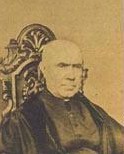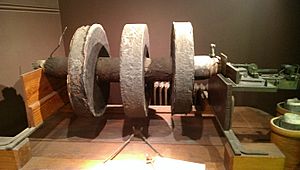Nicholas Callan facts for kids
Quick facts for kids
Nicholas Callan
|
|
|---|---|

Nicholas Callan
|
|
| Born | 22 December 1799 Darver, County Louth, Ireland
|
| Died | 10 January 1864 (aged 64) Maynooth, County Kildare, Ireland
|
| Nationality | Irish |
| Known for | induction coil |
Meet Father Nicholas Joseph Callan (born December 22, 1799 – died January 10, 1864)! He was an Irish priest and an amazing scientist from Darver, County Louth, Ireland. Father Callan taught natural philosophy (which we now call physics) at Maynooth College in County Kildare starting in 1834. He is most famous for inventing the induction coil, a device that can create powerful sparks of electricity!
Contents
Early Life and Education
Nicholas Callan went to school at an academy in Dundalk. His local priest, Father Andrew Levins, helped him begin his journey to become a priest. Nicholas started at the Navan seminary.
In 1816, he joined Maynooth College. During his third year, Callan studied natural and experimental philosophy with Cornelius Denvir. Denvir taught using experiments, and he was very interested in electricity and magnetism.
Callan became a priest in 1823. He then traveled to Rome to study at Sapienza University. In 1826, he earned a doctorate in divinity.
While in Rome, he learned about the work of early electricity pioneers. These included Luigi Galvani (1737–1798), who studied bioelectricity, and Alessandro Volta (1745–1827), who invented the electric battery.
In 1826, Callan returned to Maynooth College. He became the new professor of natural philosophy (now called physics). He also started doing his own electricity experiments in his basement laboratory at the college.
Inventing the Induction Coil
Father Callan was inspired by scientists like William Sturgeon and Michael Faraday. He began working on the idea of the induction coil in 1834. He successfully invented the very first induction coil in 1836.
An induction coil takes a low-voltage direct current (DC) and turns it into a high-voltage alternating current (AC). It has two main parts:
- A primary coil: This is a few turns of thick wire wrapped around an iron core. A low voltage, usually from a battery, is applied to this coil.
- A secondary coil: This coil has many turns of thin wire wound on top of the primary coil.
The coil also has a special part called an interrupter. This part repeatedly breaks the flow of electricity to the primary coil. This action creates a high-voltage, rapidly changing current in the secondary coil.
Callan invented the induction coil because he needed more powerful electricity for his experiments. He took a soft iron bar, about 2 feet (0.61 m) long. He wrapped two copper wires around it, each about 200 feet (61 m) long.
He connected the start of the first coil to the start of the second. Then, he connected a small battery to the beginning and end of the first coil. When he broke the battery connection, he felt a shock between the ends of the two coils.
Further experiments showed that this coil could make a small battery's shock feel as strong as a big battery's. So, Callan decided to build an even bigger coil.
With a battery of only 14 plates (each 7 inches or 178 mm), his new device produced a shock "so strong that a person who took it felt the effects of it for several days." Callan thought of his invention as a type of electromagnet. But what he had actually made was an early version of an electrical transformer.
Callan's induction coil also used an interrupter. This was a rocking wire that dipped into a small cup of mercury. This was similar to interrupters used by Charles Page. Because this device could repeatedly make and break the current, Callan called it the "repeater."
This device was actually the world's first transformer. Callan had created a high voltage in the second wire by starting with a low voltage in the first wire. He found that the faster he interrupted the current, the bigger the spark he could create.
In 1837, he built a giant induction machine. It used a clock mechanism to interrupt the current 20 times every second. This machine generated sparks 15-inch (380 mm) long! This was an estimated 60,000 volts, making it the largest artificial bolt of electricity ever seen at that time.
The 'Maynooth Battery' and Other Inventions
Father Callan also experimented with designing batteries. He found that the batteries available then were not strong enough for his work in electromagnetism.
In 1849, The Year-book of Facts in Science and Art published an article about "The Maynooth Battery." It described Callan's new and inexpensive battery. Callan shared his experiments with the Philosophical Magazine. He compared his cast-iron battery (the Maynooth battery) to a Grove's battery of the same size.
Earlier batteries often used expensive metals like platinum or less reactive materials like carbon and zinc. Callan discovered he could use inexpensive cast-iron instead of platinum or carbon.
For his Maynooth battery, he used a cast-iron outer casing. Inside, he placed a zinc plate in a porous pot. This pot had two chambers for holding different types of acid. He later improved it by using a single fluid cell, getting rid of the porous pot and needing only one solution.
While working on batteries, Callan also built the world's largest battery at that time. He connected 577 individual batteries (called "cells") together. This huge battery used over 30 gallons of acid!
Back then, there were no instruments to measure current or voltage. So, Callan measured a battery's strength by seeing how much weight his electromagnet could lift when powered by the battery. Using his giant battery, Callan's electromagnet lifted an amazing 2 tons! The Maynooth battery later went into commercial production in London.
Callan also discovered an early way to protect iron from rusting, called galvanisation. He found this while experimenting with battery design and even patented his idea.
Father Nicholas Callan passed away in 1864. He is buried in the cemetery at St. Patrick's College, Maynooth.
Legacy and Recognition
The Callan Building on the north campus of NUI Maynooth is named in his honor. NUI Maynooth was part of St Patrick's College until 1997.
Also, Callan Hall on the south campus was used for first-year science lectures in the 1990s. These included experimental and mathematical physics, chemistry, and biology.
The Nicholas Callan Memorial Prize is awarded every year. It goes to the best final-year student in Experimental Physics.
See also
- List of Catholic clergy scientists


